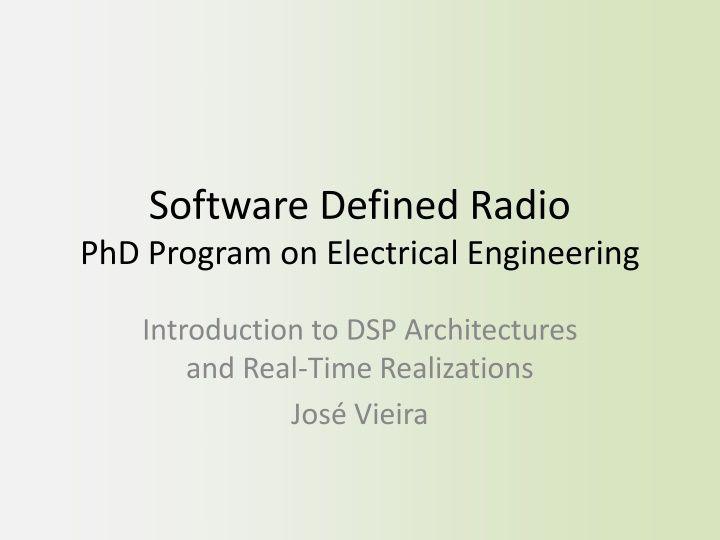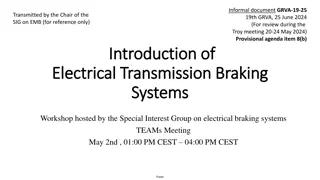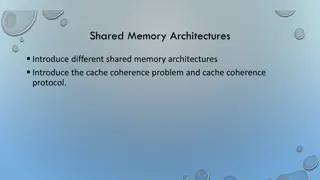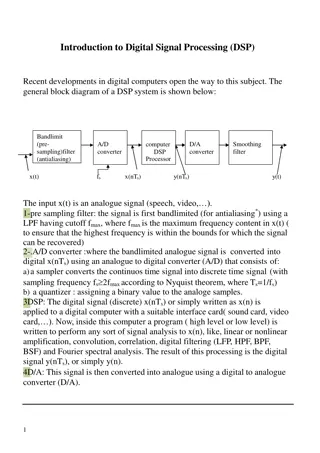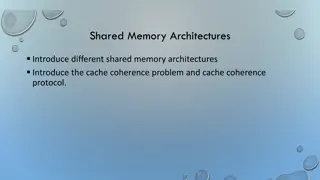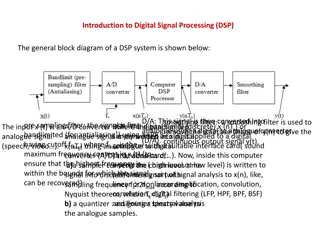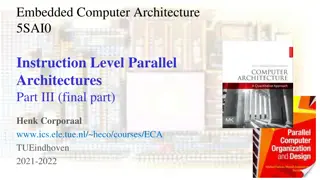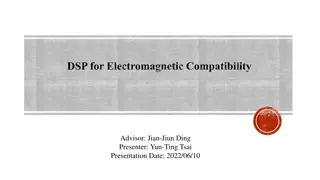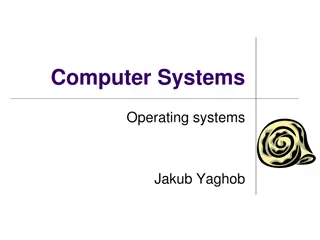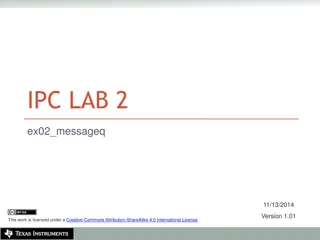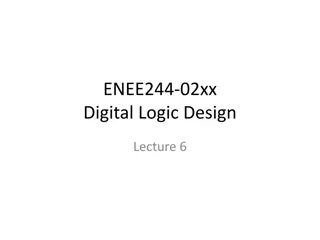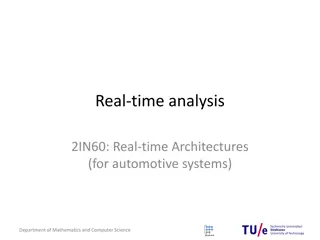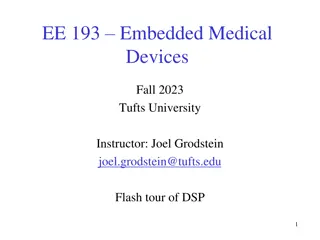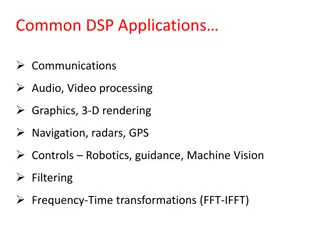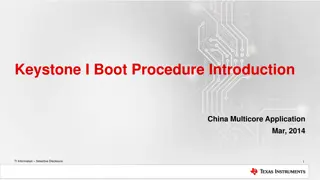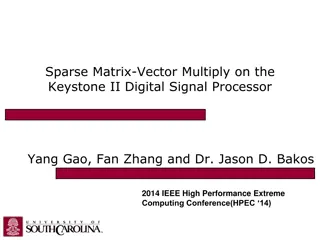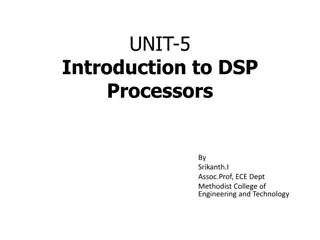Introduction to DSP Architectures and Real-Time Realizations in Electrical Engineering
This content delves into the world of Digital Signal Processing (DSP) architectures, specifically focusing on real-time realizations and their applications in electrical engineering. It covers the evolution of DSPs, main producers in the industry, historical milestones, the role of FPGAs in Software Defined Radio (SDR), and the importance of dot product operations in DSP algorithms like convolution, correlation, and FFT. Additionally, it explores key DSP algorithms such as convolution, matrix multiplication, and Accumulation. The content highlights the significance of efficient dot product operations and aims to provide a comprehensive overview of DSP technologies.
Download Presentation

Please find below an Image/Link to download the presentation.
The content on the website is provided AS IS for your information and personal use only. It may not be sold, licensed, or shared on other websites without obtaining consent from the author.If you encounter any issues during the download, it is possible that the publisher has removed the file from their server.
You are allowed to download the files provided on this website for personal or commercial use, subject to the condition that they are used lawfully. All files are the property of their respective owners.
The content on the website is provided AS IS for your information and personal use only. It may not be sold, licensed, or shared on other websites without obtaining consent from the author.
E N D
Presentation Transcript
Software Defined Radio PhD Program on Electrical Engineering Introduction to DSP Architectures and Real-Time Realizations Jos Vieira
Summary Main DSP companies Brief Introduction to the DSPs The dot product on the architecture of the DSPs The Harvard architecture The VLIW and the SIMD architectures The evolution of the DSPs The CELL processor The roles of FPGAs and DSPs on SDR 2
Main DSP Producers Texas Instruments (www.ti.com) TMS320: C1x,C2x,C5X;C80;C60 Analog Devices (www.analog.com/dsp) ADSP-21xx (SHARC) AT&T(www.lucent.com) DSP16xx;DSP32xx Motorola (www.motorola.com) DSP561xx,DSP5600xx,DSP96xx NEC, Zoran etc. 3
The Pioneers 1978 AMI S2811, first designed DSP, on the market in 1982 1979 AT&T DSP1 1980 NEC PD7720 1982 Texas Instruments TMS320C10 1982 Hitachi HD61810 first floating point DSP 4
Breve histria dos DSPs TI 70% of the market Analog Devides 2 VLIW and SIMD Floating Point Fixed Point Development Consolidation 1980 1990 2005 MDP7720 TMS320C30 TMS320C10 BLACKFIN ADSP2100 TMS320C6000 AT&TDSP32 TMS320C5000 Tiger SHARC DSP56000 TMS320C40 TMS320C80 5 Fonte: M. E. Angoletta
Dot Product The DSP has an architecture different from the other processors by having is internal architecture optimized to perform dot products efficiently The dot product operation has a main roll in most of the DSP algorithms Convolution Correlation FFT Matrix calculations 6
Dot Product 1 N = n = T ( ) ( ) a b a n b n 0 a[0] a[1] b[0] b[1] a[0] a[1] a[2] a[3] a[3] a[3] a[0] a[1] a[2] a[2] a[0] a[1] a[2] a[3] a[3] b[3] a[0] a[1] a[2] b[2] a[0] a[1] a[2] a[3] a[4] a[4] a[4] a[4] a[0] a[1] a[2] a[3] a[4] a[4] a[4] b[4] Acumulador Acumulador Acumulador Acumulador 7
DSP Algorithms Convolution, correlation, product between two matrices Multiplication and Accumulation (MAC) A*B+C=C 1. Reads two numbers from memory 2. Multiplication 3. Add 4. Moving data in memory Goal of the architecture: to perform one MAC in one clock cycle 8
Main characteristics of the DSPs Data Path Multiplier, accumulator, address generator Internal multi-access memories Special addressing modes Execution control In / Out 9
Structure of a Generic DSP Gerador de Endere os COM Links & DMA Control RAM BLOCK 0 RAM BLOCK 1 Super Bus Barrel Shifter Controlo e sequenciador ALU MUL REGISTOS Core 10
Von Neumann Architecture Data and Program share the same bus Add Mem CPU Data 11
Harvard Architecture Data and program use different buses Add CPU Program memory Add Data Memory Instruction Data 12
Harvard Architecture Implementation of Tap by cycle FIR filter: 1. Reads the instruction opcode- MAC 2. Reads one sample from the delay line 3. Reads the coefficient 4. Update the delay line 4 memory access by cycle 13
Harvard Architecture First Version CPU Add Add Program Memory Data Memory Instr Data %FIR using the TMS320C10 LT *-,Ar1; T=*delay line MPY *-,AR0; multiplies by the coef LTD *-,AR1; accumulate,move,T=*delay line MPY *-,AR0 ..... 14 Two memory access by coef
Harvard Architecture Second Version CPU Add Mem ria De Programa Add Data and Program Memory Data Memory Intruction Data %FIR EM TMS320C2x MACD m1,m2 % 1 tap in 2 cycles Withou the reading of the Opcode 1 TAP/CICLO RPTK Constant 15 MACD m1,m2
Harvard Architecture Other Versions 3 banks of internal memory (1 program + 2 for data, ex: Motorolas, C30). Fast Memories 2 or access by clock cycle - (ex: C30) Multiport memories- (ex:C50) Special memory operations 16
VLIW Architectures Multiple instructions are coded in one long word with 256 bits. Several parallel buses for high throughput The VLIW (Very Long Instruction Word)architectures has several parallel processing units The compiler has to take care of all the dependencies when distribute the tasks by the severl processing units Very difficult to program in assembly . Main goal: obtain efficient code by programming in C 17
VLIW Architectures Mem ria de Programa no DSP 32 8=256Bits (8 instru es) Unidade distribuidora L1 S1 M1 D1 L2 S2 M2 D2 Unidade de registos A Unidade de registos B Mem ria de Dados no DSP 18
VLIW Architectures Inst1 Inst2 Inst3 Inst4 Inst5 Inst6 Inst7 Inst8 L1 S1 M1 D1 L2 S2 M2 D2 8 instruction of 32 bits Processing Units 19
SIMD SIMD - Single Instruction Multiple Data The processor executes the same operation on multiple data One multiplier of 64 bits can perform 4 mul of 16bits Efficient use of the resources Difficult to program and requires an organized data 20
Processors Using SIMD TMS320C6000 da Texas Instruments TigerSHARC da Analog Devices BlackFin from Analog Devices Intel Pentium (MMX) Power PC (AltiVec) 21
SIMD Instru o SIMD MAC ALU MAC SHIFT 4 multiplica es de 16 16 bits 22
SIMD + VLIW TigerSHARC Instru o SIMD MAC ALU MAC SHIFT ALU MAC SHIFT 4 multiplica es de 16 16 bits 4 multiplica es de 16 16 bits 23
Looking Inside the DSPs The main DSP inovations
FIR on a FPGA 42 retirado do White Paper 212 XILINX
Generating MLS Pseudo-Random Sequences x(n) x(n-1) x(n-2) x(n-18) x(n-29) x(n-30) x(n-31) x(n-32) Z-1 Z-1 Z-1 Z-1 Z-1 Z-1 Z-1 + + + + sa da 1 bit 44
MLS on the C31 DSP LOOP LDI R0,R4 ;put seed in R4 LSH -31,R4 ;move bit 31 to LSB =>R4 LDI R0,R2 ;R2 = R0 = SEED LSH -30,R2 ;move bit 30 to LSB =>R2 ADDI R2,R4 ;add bits (31+30) =>R4 LDI R0,R2 ;R2 = R0 = SEED LSH -28,R2 ;move bit 28 to LSB =>R2 ADDI R2,R4 ;add bits (31+30+28) =>R4 LDI R0,R2 ;R2 = R0 = SEED LSH -17,R2 ;move bit 17 to LSB =>R2 ADDI R2,R4 ;add bits(31+30+28+17)=>R4 AND 1,R4 ;mask LSB of R4 LDIZ @MINUS,R7 ;if R4=0, R7 = MINUS value LDINZ @PLUS,R7 ;if R4=1, R7 = PLUS value LSH 1,R0 ;shift new seed left by 1 OR R4,R0 ;put R4 into LSB of R0 CALL AICIO_P ;output in R7 using AIC routine BR LOOP ;repeat for next noise sample 16 instructions to generate a MLS sample 45
Bibliografia Direct Digital Synthesis Jeffrey H. Reed, Software Radio , Prentice Hall, 2002. (Chapter 4) DSP Architecture Phil Lapsley, DSP Processor Fundamentals , IEEE Press, 1997. Paper about the DSP history Programmable DSPs: a brief overview Lee, E.A.; Micro, IEEE , Volume: 10 , Issue: 5 , Oct. 1990, pp.14-16 Paper about the DSP evolution The Evolution of DSP Processors Jennifer Eyre and Jef Bier, IEEE Signal Processing Magazine, Vol 17, n 2, March 2000, pp. 43-51 46
